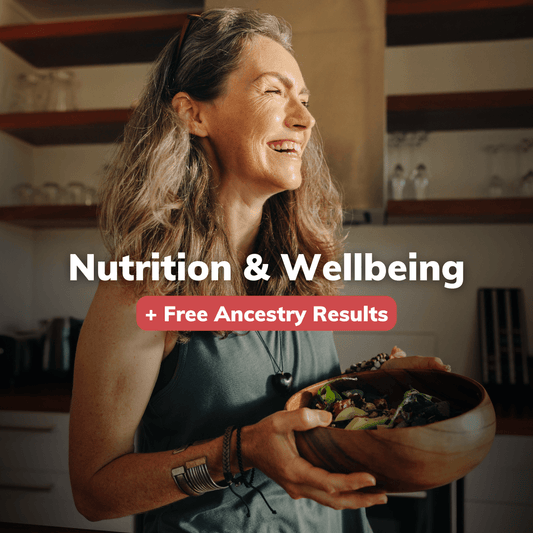
Genetic Variations - DNA changes that make us unique
BioCertica Content TeamWritten by: Nermin Đuzić, M.Sc. in Genetics, Content Specialist
Every person on the Earth has a unique genetic makeup, except for identical twins. Although identical twins have the same genetic makeup only at birth, As it is affected and changed by environmental factors and lifestyle, that’s a different story [1].
Humans are a relatively young species, so we did not have too much time to accumulate a large amount of genetic variation [2]. Each human being possesses 3 billion base pairs within the genome. Out of that, any two individuals have on average 3 million base pairs that are different. It may seem like a huge number, but the fact is that it comprises only 0.1% of the entire human genome [3].
What is genetic variation?

Before discussing genetic variation, we will give you a brief reminder of what we have written about. The 3 billion base pairs of our DNA are tightly packed in chromosomes and constitute approximately 30,000 genes along with intergenic regions. Genes contain information on how our body will produce proteins. Triplets of the above-mentioned base pairs correspond to specific amino acids that produce proteins required for your body to develop and function.
Now, let’s get back to genetic variations. Genetic variations are slight changes in the genetic sequences of two given individuals that make them different. These changes occur in the translation of DNA base pairs into proteins either at random or due to environmental factors. These changes may affect your health and well-being, but it does not have to be the case—more on that in the following sections [4].
What are major types of genetic variations?
A common genetic variation is a change at the DNA level that affects a single nucleotide or more nucleotides. It is called a mutation and may cause an individual to be more prone to certain conditions like sickle cell anemia, hemophilia, etc. However, not all mutations are dangerous, as we have three types of gene mutations based on the effect they make [5]:
a) Missense mutations – cause a change in the amino acid sequence of a protein, resulting in either significant or slight changes to protein function.
b) Nonsense mutations – cause immediate termination of protein sequence, which results in a shorter and truncated protein that can be entirely dysfunctional.
c) Silent mutations – do not change the overall protein sequence and therefore do not impact health.

Besides the classification as mentioned above, there are other classifications of genetic variations [6, 7]:
- Insertions (a portion of DNA inserted elsewhere)
- Deletions (a portion of DNA deleted)
- Duplication (a portion of DNA duplicated)
- Transversions and Transitions (interchanges of DNA segments)
- Chromosomal aberrations and rearrangements (rearrangements of large chunks of a chromosome or chromosomes)
- Single nucleotide polymorphisms (SNPs) (single base-pair is substituted by another one)
- Short tandem repeats (STRs) (short DNA sequence tandemly repeated)
- Copy number variations (the number of copies of a particular gene varies between individuals).
All these types of genetic variations have important implications in health and evolutionary genetics. Moreover, they have various applications in diagnostics, medicine, forensics, and pharmacogenomics. Without too many details, we will explain single nucleotide polymorphisms (SNPs) later in this article. They are among the most abundant and important ones and ones we are using for our tests.
What are examples of positive and negative mutations?
To simplify, we can say that the above-mentioned genetic variations can have positive, negative, or no effects. In other words, if a change or mutation happens, it does not have to be always negative, causing a disease. It can also be positive, therefore driving the adaptation or survival of the organism and whole species in a given environment.
For example, mutations in the CR5 gene may protect against autoimmune deficiency syndrome (AIDS), making it more difficult for the HIV virus to invade the cells.
Sickle cell anemia is a hereditary condition characterized by sickle/crescent-shaped red blood cells that get stuck in small blood vessels and slow or block blood flow and oxygen supply. Symptoms include pain, swelling, tiredness, etc. [8].
A mutation that causes sickle cell anemia can benefit the individuals affected by it. Individuals with this mutation are more resistant to malaria, which is caused by a parasite Plasmodium and spread by mosquitoes, all because of the shape of their blood cells affected by the mutation. Otherwise, some genetic variations have a negative effect. Again, single-gene-mutation disorders like cystic fibrosis and Huntington’s disease are caused by a single nucleotide replacement [9, 10].
Either positive or negative, the fact is that genetic variations arise from mutations, and mutations are a key evolutionary force and the ultimate source of what makes us different from each other. Other evolutionary forces are that drive changes in populations:
- gene flow (movement of genes between different groups of organisms),
- genetic drift (random changes of frequency of genetic alleles),
- natural selection (ability to survive better than others in the particular environment due to genetic makeup). [11]
Single Nucleotide Polymorphism (SNP)

Single-nucleotide polymorphisms (SNPs) are the most common type of genetic variation, occurring once at about every 1,000 bases [12, 13]. SNP is the DNA sequence variation when a single nucleotide in the individual’s genome differs from the same nucleotide in the genome of another individual. For example, let’s take a look into the following two nuclear DNA sequences:
Sequence 1: AAGCCTA
Sequence 2: AAGCTTA
This single nucleotide shift of cytosine from sequence 1 to thymine in sequence 2 represents single nucleotide polymorphism.
SNPs are the most frequent type of polymorphisms, and they have their advantages and disadvantages. There are many advantages of SNPs:
- They are very abundant, which makes them highly available for analysis and, therefore, very useful.
- Genotyping can be automated.
- Their detection will work with highly degraded DNA samples
- Available for simple interpretation because there are no artifacts
- Have a broad spectrum of applications [14]:
o Diagnostics/risk profiling
o Ethnic profiling/ancestry analysis
o Drug response prediction
o Gene discovery, mapping, and function identification
o Comparing differences between individuals ( forensics applications).
However, there are also some disadvantages to be considered [15]:
- They may provide low information content compared to other polymorphisms because they are mainly bi-allelic, meaning they include only either of two variants. However, there are also multiallelic SNPs (having multiple alleles).
- It may represent a challenge in determining the exact genotype (variants structure) when interpreting mixture in forensics applications for a kinship investigation.
- SNPs have lower mutation rates than STRs, which may present limitations in their interpretation.
Generally, most genetic variations are “harmless” or often called “neutral,” meaning that they do not affect our ability to survive or adapt. Still, some of them are very important and play crucial roles affecting our health and well-being.
At BioCertica, we analyze your genetic makeup and look for specific SNPs and their correlation with particular traits and conditions. Examples of SNPs we analyze are SNPs of the MC4R gene. This gene comes in different allele combinations.
The A allele is associated with obesity and increased waist circumference [16]. People with an AA variant of the MC4R gene have a 1.8 cm larger waist than average; adults with an AG variant have a 0.9 cm larger waist, while those with GG variants have a regular waist. This gene does not confer them a risk of obesity.
Allele C is associated with increased body mass index (BMI), especially in children [17]. CC variant carriers tend to have f.44 higher BMI units; CT variants have 0.22 higher units, while TT variants do not contribute to the overall BMI value.
These SNPs are related to the ability to manage obesity, which is one of the features we offer in our Weight management DNA kit.
How are SNPs related to disease prevention?
As explained in one of the previous articles, some traits and health conditions are products of genes and environmental interactions. Some human characteristics can be changed by human intervention, and others cannot. Here we may introduce the most beneficial application of SNPs – for disease risk identification and disease prevention. Let us explain this through a truly tragic story that happened in the past.
You may have heard of Ekaterina Gordeeva and Sergei Grinkov, former young married Russian figure skaters, who had won two Olympic medals in the pairs competition. They expected to write many success stories together.
But the happy story ended in November 1995, when 28-year-old Sergei suddenly collapsed and died during a practice session. He was physically fit, a non-smoker, and was not an alcohol consumer, and there had been no warning signs. The question is: What happened to him?
Analyses showed that he was born with a mutation in a single gene which affects the formation of blood clots. This mutation, called platelet antigen-2 (PLA-2), can cause clots to form in the wrong place at the wrong time. Due to this mutation, Sergei Grinkov had an increased relative risk for a sudden heart attack [18].
It appears that PL(A2) mutations interact negatively with cholesterol in the blood. Thus, someone with this mutation may reduce their risk of a heart attack by maintaining a low cholesterol diet and exercising regularly.
While genetic mutations are sporadic, we continue to learn more about how SNPs affect disease risk. At BioCertica, we offer various DNA tests that give you insights into your genetic makeup and risks for specific health conditions. Check them immediately!
References
- Chatterjee, A., & Morison, I. M. (2011). Monozygotic twins: genes are not the destiny?. Bioinformation, 7(7), 369.
- National Institutes of Health (US); Biological Sciences Curriculum Study. NIH Curriculum Supplement Series [Internet]. Bethesda (MD): National Institutes of Health (US); 2007. Understanding Human Genetic Variation.
- Crow, J. F. (2002). Unequal by Nature: A Geneticist’s Perspective on Human Differences. Daedalus, 131(1), 81–88.
- Griffiths AJF, Gelbart WM, Miller JH, et al. Modern Genetic Analysis. New York: W. H. Freeman; 1999. Genetics begins with Variation.
- Muller, H. J. (1950). Our load of mutations. American journal of human genetics, 2(2), 111.
- Ku, C. S., Loy, E. Y., Salim, A., Pawitan, Y., & Chia, K. S. (2010). The discovery of human genetic variations and their use as disease markers: past, present, and future. Journal of human genetics, 55(7), 403-415.
- Lodish H, Berk A, Zipursky SL, et al. Molecular Cell Biology. 4th edition. New York: W. H. Freeman; 2000. Section 8.1, Mutations: Types and Causes.
- Sickle cell anemia. (2021, July 17). Retrieved from Sickle Cell Anemia-Symptoms & Causes
- Rees, J. S., Castellano, S., & Andrés, A. M. (2020). The genomics of human local adaptation. Trends in Genetics, 36(6), 415-428.
- Loewe, L., & Hill, W. G. (2010). The population genetics of mutations: good, bad and indifferent.
- Sunyaev, S., Kondrashov, F. A., Bork, P., & Ramensky, V. (2003). Impact of selection, mutation rate and genetic drift on human genetic variation. Human Molecular Genetics, 12(24), 3325-3330.
- Colbert, R. A. & Glass, D. N. (2005).Chapter 4: INTEGRATIVE GENOMICS. Textbook of Pediatric Rheumatology (Fifth Edition). Pages 64-75
- Via, M., Gignoux, C., & Burchard, E. G. (2010). The 1000 Genomes Project: new opportunities for research and social challenges. Genome medicine, 2(1), 1-3.
- Schork, N. J., Fallin, D., & Lanchbury, J. S. (2000). Single nucleotide polymorphisms and the future of genetic epidemiology. Clinical genetics, 58(4), 250-264.
- Amorim, A., & Pereira, L. (2005). Pros and cons in the use of SNPs in forensic kinship investigation: a comparative analysis with STRs. Forensic science international, 150(1), 17-21.
- Chambers, J. C., Elliott, P., Zabaneh, D., Zhang, W., Li, Y., Froguel, P., ... & Kooner, J. S. (2008). Common genetic variation near MC4R is associated with waist circumference and insulin resistance. Nature genetics, 40(6), 716-718.
- Loos, R. J., Lindgren, C. M., Li, S., Wheeler, E., Zhao, J. H., Prokopenko, I., ... & Barroso, I. (2008). Common variants near MC4R are associated with fat mass, weight and risk of obesity. Nature genetics, 40(6), 768-775.
- Bickel, T., Prasad Gunasekaran, G. M., Gopinathannair, R., Gunda, S., & Lakkireddy, D. (2019). Sudden Cardiac Death in Famous Athletes, Lessons Learned, Heterogeneity in Expert Recommendations and Pitfalls of Contemporary Screening Strategies. Journal of Atrial Fibrillation, 12(4).



